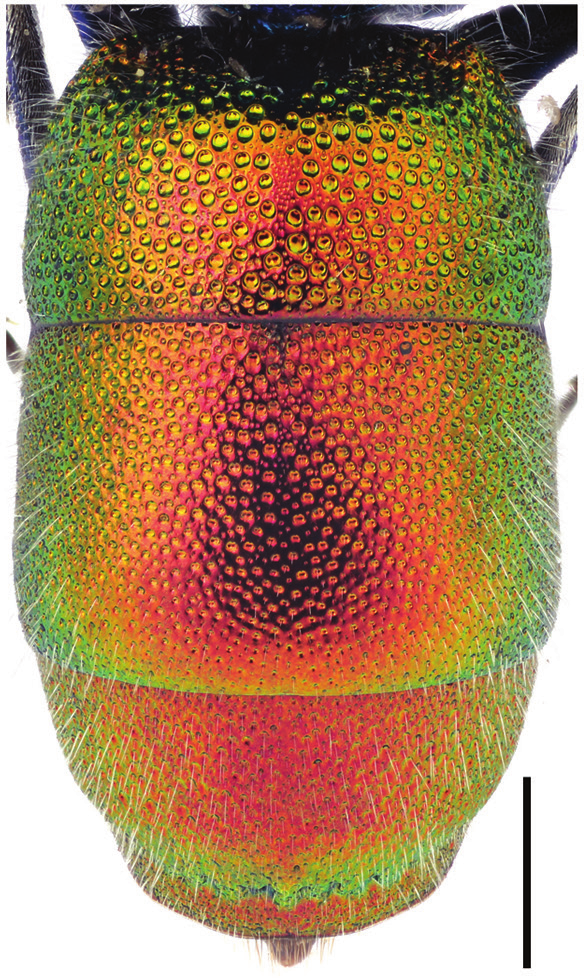Chrysura radians
Figure 200
Chrysura radians ♀. Scale 1 mm.
A relatively rare species only found in forest margins as well as open habitats. The hosts include several species of mason bees Osmia. The genus can be recognised by the lack of a frontal carina and the lack of apical teeth along hind margin of T3. C. radians can be separated from C. hirsuta by the lack of long dark hairs of T3, and the more scattered punctation of the tergites.
- Innhold
- Diagnosis
- Distribution
- Biology
Diagnosis
Figure 204
Antenna: C. radians ♂. Scale 1 mm.
Figure 207
Metasoma, dorsal view: C. radians ♀. Scale 1 mm.
Length 8–11 mm.
The species differs from other similarly coloured species of the genus by its heterogeneous tergal punctation, which consists of large punctures and interspersed small punctures (Figs 200, 207). The metascutellum is slightly elevated (but not as sharply as in C. trimaculata) and has a large triangular fovea antero-medially. The head and mesosoma are mainly green or blue, whereas the metasoma is dorsally golden red or violet-red (Fig. 200). The punctures on the pronotum, mesoscutum and mesoscutellum are often contrastingly blue compared to the greenish interstices.
Distribution
Denmark, Estonia, Latvia, Lithuania, Norway, Sweden. Relatively rare.
Trans-Palearctic: from western Europe and northern Africa to western Asia and Siberia (Linsenmaier 1959).
Be aware that the records present in the GBIF map may be misleading for some countries due to unrevised data sets or missing information.
GBIF Taxon: Chrysura radians (Harris, 1776)Biology
Habitat: forest margins, clearings and gardens with sun-exposed dead wood. Occasionally also found on brick walls, clay walls or rocky outcrops (Trautmann 1927). Adults visit flowers of Apiaceae and Euphorbiaceae (Rosa 2004) and also feed on honeydew of aphids (Linsenmaier 1997).
Flight period: June to August.
Host: solitary bees of Osmia Panzer and Hoplitis Klug (Megachilidae), which usually nest in cavities in dead wood. In North Europe, probably mainly Hoplitis adunca (Panzer), H. anthocopoides (Schenck), Osmia caerulescens (Linnaeus) and/or Osmia leaiana (Kirby) (Frey-Gessner 1887, du Buysson 1891, Trautmann 1927, Stöckhert 1933).



